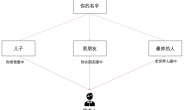在之前的博文中,Jmeter二次开发——基于Java请求,已介绍了Jmeter二次开发的基础情况,上次分享的是java请求开发,今天来分享下Jmeter中的函数开发。聊到Jmeter的函数,知道Jmeter使用的博友肯定很熟悉。Jmeter自带一个函数库,有很多的函数,比如:__P,__Random,函数助手给我们提供了很多的方便之处。函数助手使用如下所示:
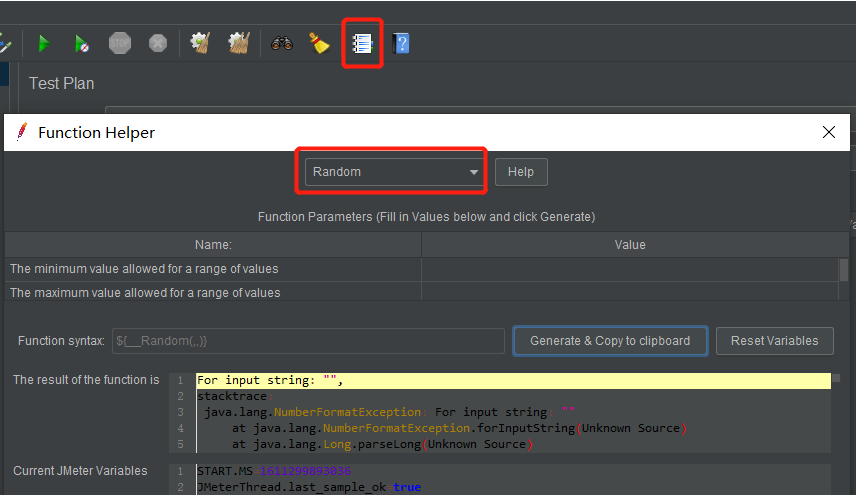
但有些时候,自带的函数满足不了真实的测试场景,比如:生成随机手机号。常规做法,应该是设定手机号区号的固定值,再通过__Random函数生成8位随机数,从而拼接成一个手机号,这样的做法的确可以满足,但要想手机号的区段也是随机的呢,是不是就不太好处理了。那就用函数二次开发试试。
函数二次开发
创建以functions结尾的包
这个是特别需要注意点,以.functions结尾,正常创建包即可。
类继承AbstractFunction
二次开发时,新建的类,需要继承AbstractFunction,这个也是需要注意的。至于为什么需要继承AbstractFunction,看源码就能明白,源码如下所示:
public abstract class AbstractFunction implements Function {
public AbstractFunction() {
}
public abstract String execute(SampleResult var1, Sampler var2) throws InvalidVariableException;
public String execute() throws InvalidVariableException {
JMeterContext context = JMeterContextService.getContext();
SampleResult previousResult = context.getPreviousResult();
Sampler currentSampler = context.getCurrentSampler();
return this.execute(previousResult, currentSampler);
}
public abstract void setParameters(Collection<CompoundVariable> var1) throws InvalidVariableException;
public abstract String getReferenceKey();
protected JMeterVariables getVariables() {
return JMeterContextService.getContext().getVariables();
}
protected void checkParameterCount(Collection<CompoundVariable> parameters, int min, int max) throws InvalidVariableException {
int num = parameters.size();
if (num > max || num < min) {
throw new InvalidVariableException(this.getReferenceKey() + " called with wrong number of parameters. Actual: " + num + (min == max ? ". Expected: " + min + "." : ". Expected: >= " + min + " and <= " + max));
}
}
protected void checkParameterCount(Collection<CompoundVariable> parameters, int count) throws InvalidVariableException {
int num = parameters.size();
if (num != count) {
throw new InvalidVariableException(this.getReferenceKey() + " called with wrong number of parameters. Actual: " + num + ". Expected: " + count + ".");
}
}
protected void checkMinParameterCount(Collection<CompoundVariable> parameters, int minimum) throws InvalidVariableException {
int num = parameters.size();
if (num < minimum) {
throw new InvalidVariableException(this.getReferenceKey() + " called with wrong number of parameters. Actual: " + num + ". Expected at least: " + minimum + ".");
}
}
protected final void addVariableValue(String value, CompoundVariable[] values, int index) {
if (values.length > index) {
String variableName = values[index].execute().trim();
if (StringUtils.isNotEmpty(variableName)) {
JMeterVariables vars = this.getVariables();
if (vars != null) {
vars.put(variableName, value);
}
}
}
}
}
参数解释
getArgumentDesc()
获取界面所要显示的参数说明
execute()
函数的主体业务
getReferenceKey()
获取函数的名称
setParameters()
设置参数,接收用户传递的参数
checkParameterCount()
检测参数数量是否准确
函数开发
获取函数的名称
名称自定义,如下所示:
private static final String key = "__XXX";
这里需要注意的是:函数开头是以2个下划线开头。
名称定义好了,那如何获取呢?就用我们刚才说的方法获取即可,如下所示:
@Override
public String getReferenceKey() {
return key;
}
获取界面所要显示的参数说明
在Jmeter的函数助手中,对应函数都有对应的参数说明,如下所示:

那如何配置能实现呢?代码如下:
private final static List<String> args = new LinkedList<String>();
static{
args.add("界面参数");
}
如果有多个参数怎么办?多个参数,多个args.add即可
获取参数名称,同样用刚才介绍的方法获取即可,如下所示:
@Override
public List<String> getArgumentDesc() {
return args;
}
获取参数值
@Override
public void setParameters(Collection<CompoundVariable> args0) throws InvalidVariableException {
//检测用户调用函数时,检查参数个数,个数不对则报错
checkParameterCount(args0,3);
Object[] params = args0.toArray();
//转换只为string
telNum = ((CompoundVariable)params[0]).execute();
start = ((CompoundVariable)params[1]).execute();
end = ((CompoundVariable)params[2]).execute();
}
获取参数值中,可以检测函数的入参个数是否准确,不准确则会报错,报错信息如下所示:
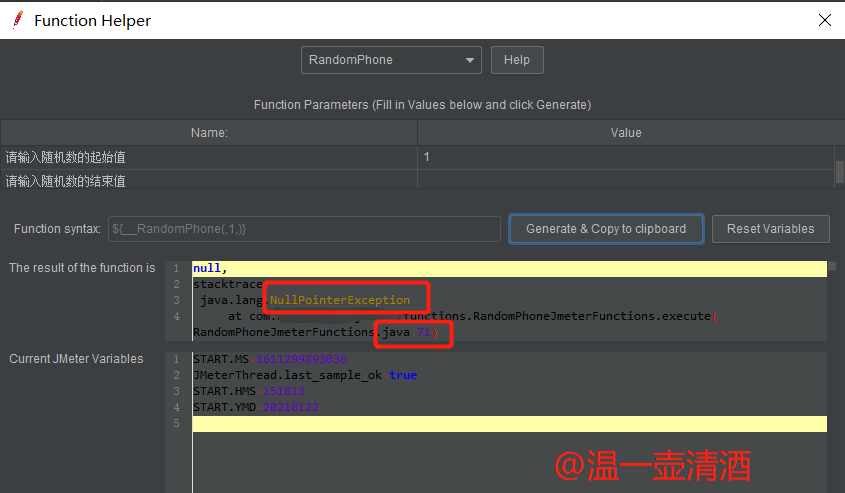
函数的主体业务
介绍到这,就是函数的核心内容了,该函数要实现什么功能,就是在该方法中处理,示例代码如下所示:
@Override
public String execute(SampleResult sampleResult, Sampler sampler) throws InvalidVariableException {
SampleResult sampleResult1 = new SampleResult();
try {
sampleResult1.sampleStart();
int index=getNum(0,telFirst.length-1);
String telNum = telFirst[index];
String two = String.valueOf(getNum(1, 888) + 10000).substring(1);
String three = String.valueOf(getNum(1, 9100) + 10000).substring(1);
tel = telNum + two + three;
logger.info("手机号区段:"+ telNum +" 随机生成的手机号是:" + tel);
if (varName != null) {
JMeterVariables vars = getVariables();
final String varTrim = varName.execute().trim();
if (vars != null && varTrim.length() > 0) {
vars.put(varTrim, telNum);
}
}
sampleResult1.setResponseData("手机号区段:"+ telNum +" 随机生成的手机号是:" + tel,"utf-8");
sampleResult1.setSuccessful(true);
}catch (Exception e){
sampleResult.setSuccessful(false);
e.printStackTrace();
}finally {
sampleResult1.sampleEnd();
}
return tel;
}
代码调试
写到这里,基本完成了,但还是得测试下,功能是否正常,如果先打jar包,丢到Jmeter中,发现有bug的话,来来回回处理,就折腾了,所以还是需要先测试下的。
在test下新建测试类,示例代码如下所示:
import org.junit.Test;
public class Function_Test {
@Test
public void phoneTest() throws Exception {
RandomPhoneJmeterFunctions randomPhone= new RandomPhoneJmeterFunctions();
String phoneString = randomPhone.execute();
System.out.println("随机手机号:" + phoneString);
}
}
测试代码很简单,运行测试类,没有报错并打印出手机号,则说明没有问题。运行后的结果如下所示:

生成jar包
生成jar包就不重复讲了,可以看以前的博文,IDEA的基本操作——导入导出jar包
Jmeter中使用
代码写好后,自然是要在jmeter中验证下功能的,我们将生成的jar包放到jmeter的\lib\ext文件夹下,如果jmeter已启用,则需要重启哦,不然不会生效。
打开jmeter后,使用函数助手,看新开发的函数是否有展示,如下所示:
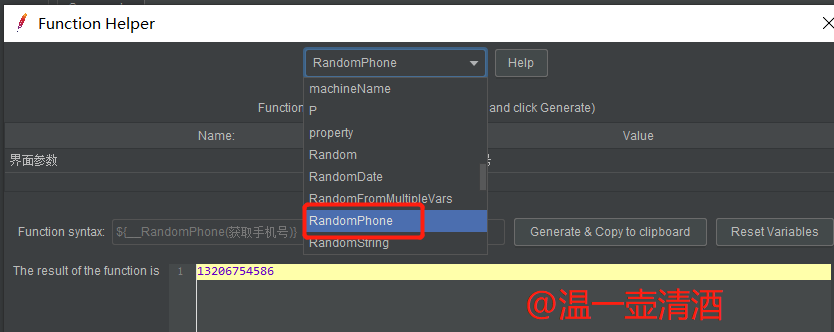
生成函数变量,操作如下所示:
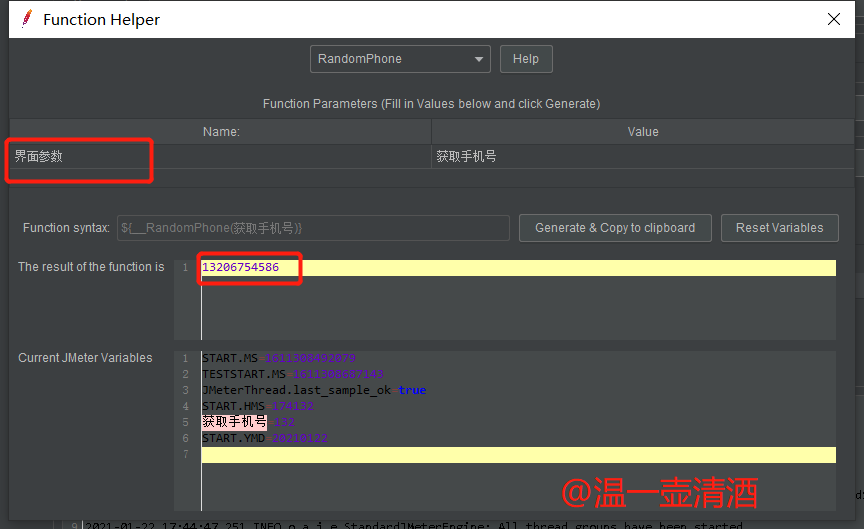
新建线程组,并添加http请求,验证码生成的手机号是不是随机的,运行后,查看结果树,如下所示:
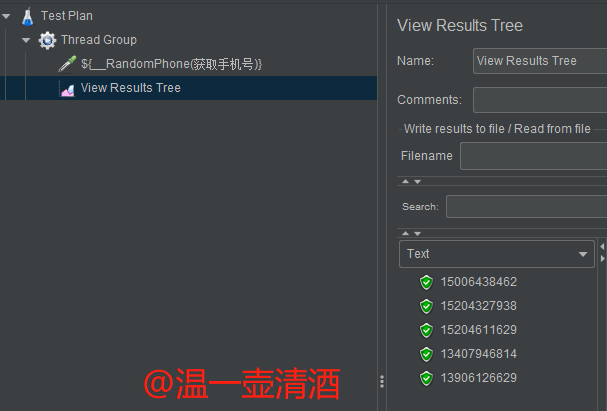
也可以通过日志查看,开发的时候,加了响应日志,如下所示:
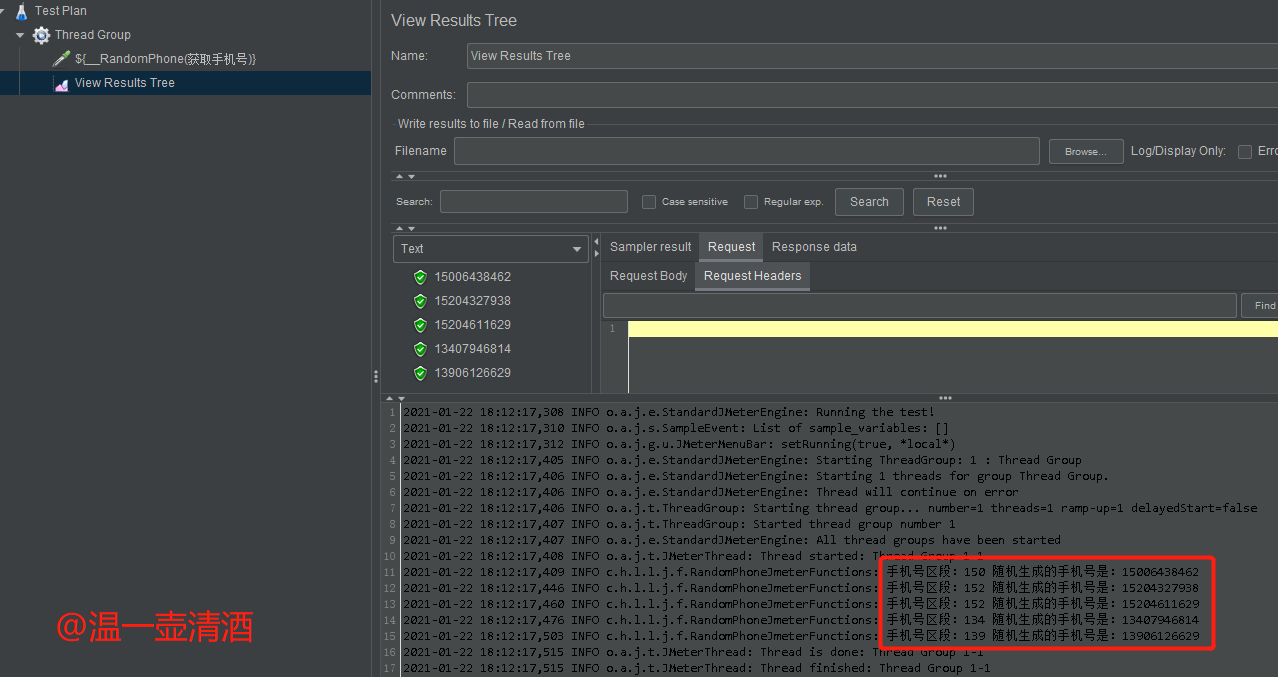
到此,就说明功能没问题了。函数开发按上述步骤就可以完成,遇到不满足测试场景的时候,就可以自己diy一个了。
最后附上完整代码,如下所示:
private static Logger logger = LogManager.getLogger(RandomPhoneJmeterFunctions.class.getName());
private String tel;
//定义函数名称
private static final String KEY = "__RandomPhone";
//定义函数界面显示的参数名称
private static final List<String> desc = new LinkedList<String>();
static{
desc.add("界面参数");
}
private static final String[] telFirst = "134,135,136,137,138,139,150,151,152,157,158,159,130,131,132,155,156,133,153 ".split(",");
private CompoundVariable varName;
//业务主逻辑
@Override
public String execute(SampleResult sampleResult, Sampler sampler) throws InvalidVariableException {
SampleResult sampleResult1 = new SampleResult();
try {
sampleResult1.sampleStart();
int index=getNum(0,telFirst.length-1);
String telNum = telFirst[index];
String two = String.valueOf(getNum(1, 888) + 10000).substring(1);
String three = String.valueOf(getNum(1, 9100) + 10000).substring(1);
tel = telNum + two + three;
logger.info("手机号区段:"+ telNum +" 随机生成的手机号是:" + tel);
if (varName != null) {
JMeterVariables vars = getVariables();
final String varTrim = varName.execute().trim();
if (vars != null && varTrim.length() > 0) {
vars.put(varTrim, telNum);
}
}
sampleResult1.setResponseData("手机号区段:"+ telNum +" 随机生成的手机号是:" + tel,"utf-8");
sampleResult1.setSuccessful(true);
}catch (Exception e){
sampleResult.setSuccessful(false);
e.printStackTrace();
}finally {
sampleResult1.sampleEnd();
}
return tel;
}
//获取参数值
@Override
public void setParameters(Collection<CompoundVariable> args0) throws InvalidVariableException {
//检测用户调用函数时,检测参数个数
checkParameterCount(args0,1);
Object[] params = args0.toArray();
if (params.length > 0) {
varName = (CompoundVariable) params[0];
} else {
varName = null;
}
}
//获取函数的名称
@Override
public String getReferenceKey() {
return KEY;
}
//获取界面所要显示的参数说明
@Override
public List<String> getArgumentDesc() {
return desc;
}
private static int getNum(int start,int end)
{
return (int)(Math.random()*(end-1));
}



